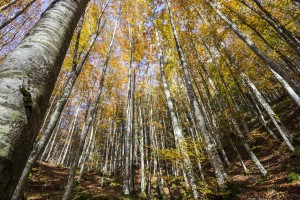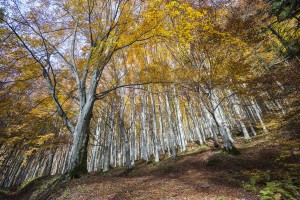
©Bigstock.com/Cristina_Annibali_Krinaphoto
Most UNESCO World Heritage Site are restricted to a single place or region rarely crossing borders. However, there are a few quite gigantic exceptions. One of them was summarised under the extensively long name “Ancient and primeval beech forests of the Carpathians and other regions of Europe”. While being limited to several areas in Germany, Slovakia und Ukraine until its expansion in 2017, this site now also includes various regions in Albania, Austria, Belgium, Bulgaria, Croatia, Romania, Slovenia and Spain – and Italy, obviously. Six beautiful regions with a total area of 2,127 ha stretch across swaths of the country. Are you ready for this particularly natural experience?
Why the ancient and primeval beech forests deserve protection
But why is it that “some forests” made it onto the illustrious list of UNESCO World Heritage Sites? Well now, the ancient and primeval beech forests are everything but that. Bearing witness to the last Ice Age, they cover Central Europe. However, their number and total area shrunk decisively over the course of centuries during growing regional populating and industrialisation. The European beech per se is unbelievably adaptable and even impressively weathered sufficient changes in its environment. At the same time, their expansion ran parallel to the history of human sedentariness. As such, the use of the beech from the Middle Ages onward with the concurrent reduction of primeval beech forests carries great importance in cultural studies.

©Bigstock.com/Cristina_Annibali_Krinaphoto
The protected beech forests are located in realms that are as unaffected by human interference as possible and spread across various climes from alpine to Mediterranean. The six sites of the ancient and primeval beech forests in Italy are spread across both western and eastern coasts in some of the most picturesque regions of the country perfectly illustrating the versatility of this unique tree. You’d like to learn more about the various parts of this Italian World Heritage Site? Time to go on a little journey.
National Park of Abruzzo, Latium and Molise
One of the biggest national parks of the country also holds the largest beech forest area in the Italian part of the conservation area. An astonishing 936 ha are spread across the forested Coppo del Morto, Selva Moricento, Val Fondillo, Valle Cervara and Coppo del Principe. The beeches at Valle Cervara at an altitude of up to 1,850 m are up to 560 years old making them the oldest in all of Europe and even the entire northern hemisphere! Several streams run through Val Fondillo enlivening this already unique habitat even more. Rare species, such as the fire salamander, are native to this moist forest. The other beech forests in the National Park of Abruzzo, Latium and Molise are also home to a ravishing diversity of flowers and species. Wolves and brown bears settled down here as well as the chiffchaff and rare bogs and fungi.
Pollino National Park
In contrast, the ancient beech forests of Cozzo Ferriero in Rotonda are a fairly small yet neat affair. The 96 ha in the Province of Potenza in Basilicata on the border to Calabria are a bit younger – up to 500 years old – also forming the core of the southernmost old beech forests in Europe. The imposing tree giants on an altitude of up to 1,750 m provide scientists with interesting insights into the effects and impact of climate change on the tree population. Guides hikes and mountain tours in small groups on pretty steep paths bring you closer to this natural idyll – surefootedness and mountain experience are a must.
Gargano National Park
The large national park in Apulia is actually better known for its sweeping pine tree forests. However, our beech trees dominate the scenery in Foresta Umbra, which approximately translates to “dark forest” or “shady forests”. The region can be divided into four different zones. D and C invite you to go on divine walks while B is the actual conservation area. However, all walkers and tourists are prohibited from entering zone A. The holly oak of Vico del Gargano in front of a Franciscan monastery among the forest remnants of Nemus Garganicum, one of the largest Central European broad-leaved forests, carries special significance. It is shrouded in many a legend.
Monte Cimino
Find just under 60 hectares of beech forest on the 1,053 m high Monte Cimino, part of a smaller low mountain range in the Province of Viterbo in Latium. Here you come across genuine survivalists. Many beech forests were gradually converted into larch forests over the course of centuries (some parts even as early as the Bronze Age) by utilising clear felling and selective cutting. The remaining beeches were quickly put under environmental protection. Nowadays, they are only partially accessible via walking and hiking trails, but they are situated in a region of particular historical significance that you simply have to visit.
Regional Natural Park Bracciano – Martignano
The lowest-altitude beech forest of the Italian World Heritage Site is near Oriolo Romano. Monte Raschio’s comparatively plain location at 542 m is extraordinary by itself. Why, you probably wonder, did the beech forests still manage to grow and thrive in the Regional Natural Park Bracciano – Martignano in quaint Latium? Above-average levels of volcanic earth allowed these giants to sprout. They provide wonderful shade during highly enjoyable walks.
Foreste Casentinesi National Park
Your final stop is Emilia Romagna, where you travel to Sasso Fratini, a conservation area that was established as early as 1959 and is very difficult to access. The craggy rock slopes prevented deforestation, access ways are extremely scarce. This allowed the ancient beeches to grow and thrive gloriously. Some of them are over 500 years old. Accessing this nature reserve, however, is strictly prohibited. You’ll still find numerous walking and hiking trails throughout the entire Foreste Casentinesi National Park, which, by the way, also stretches into Tuscany, bringing you in close proximity to the amazing tree giants. You’ll most certainly be able to see a few of them.
Are you ready for your journey to Italy’s majestic natural sites? Even though you might not always be able to access the ancient and primeval beech forests themselves – with good reason, as you’ll surely agree – there are still so many options and opportunities to actively explore and experience the parks and conservation areas in peace and quiet. There are only very few places left where natural history is as palpable as here. Let’s keep them alive and well together.